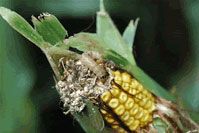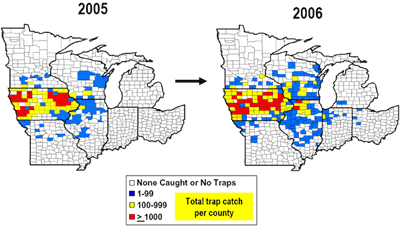Indianapolis, Indiana
August 31, 2006
If there’s a corn insect that has
the inside track to Pest of the Year, it’s got to be the western
bean cutworm (WBCW).
Once
considered a pest of the Plains, WBCW used to make its living
raiding eastern Nebraska cornfields, then withdrawing back to
its home of dry beans and sandy soils in western Nebraska. While
WBCW has been present in Iowa since the turn of the decade, it
often didn’t show up at levels that caused economic damage. That
changed this summer with outbreak levels of WBCW throughout much
of the state.
 For
those corn growers who chose either the in-plant trait
Herculex® I Insect Protection or Herculex XTRA Insect
Protection over YieldGard, they were protected against WBCW.
Other producers were left scrambling for a rescue spray to stop
the outbreak. For
those corn growers who chose either the in-plant trait
Herculex® I Insect Protection or Herculex XTRA Insect
Protection over YieldGard, they were protected against WBCW.
Other producers were left scrambling for a rescue spray to stop
the outbreak.
“Many
producers who grew corn with the YieldGard trait saw significant
damage,” says Kelly Montgomery, product development agronomist
for Dow AgroSciences
in Iowa. “They did so believing western bean cutworm would not
be a problem and, needless to say, they weren’t thrilled with
having to spend the extra money on insecticide to control
western bean cutworm.
“In many
cases, the larvae had already made their way into the silks
before being discovered, which meant it was too late to control
them and the grower was going to have to live with whatever
damage occurred.”
The
western bean cutworm moves east
 The
Western Bean Cutworm Monitoring Network* paints a vivid
picture of the level of infestation that occurred this past
summer in Iowa. Eighty of the state’s 99 counties had traps set
in place to monitor WBCW moth flights. As of Aug. 4, 63 counties
had seen moth captures at levels of greater than 100 per week.
Of those, 38 had seen moth captures of greater than 500 per
week. The
Western Bean Cutworm Monitoring Network* paints a vivid
picture of the level of infestation that occurred this past
summer in Iowa. Eighty of the state’s 99 counties had traps set
in place to monitor WBCW moth flights. As of Aug. 4, 63 counties
had seen moth captures at levels of greater than 100 per week.
Of those, 38 had seen moth captures of greater than 500 per
week.
Now,
WBCW appears to have its sight set on cornfields east of
the Mississippi River. Seven counties in northwestern Illinois;
Vernon and Crawford counties along the Mississippi River in
Wisconsin; and Newton County in northwestern Indiana captured
moths at levels of greater than 100 per week.
Additionally, moths
were captured for the first time in
Michigan and Ohio
during 2006.
“The outbreak
in Iowa and the high levels of western bean cutworm in northwest
Illinois really made it evident that western bean cutworm is a
game-changing pest,” says Lyndall Dallas, product development
agronomist for Dow AgroSciences in Illinois. “Growers throughout
much of the Corn Belt now have to factor western bean cutworm
into their management plans.
 “Based
on the activity of western bean cutworm this year and its
continued eastward movement, it’s pretty safe to say that this
is a pest that’s here to stay. Growers need to determine their
tolerance for this pest.” “Based
on the activity of western bean cutworm this year and its
continued eastward movement, it’s pretty safe to say that this
is a pest that’s here to stay. Growers need to determine their
tolerance for this pest.”
Dallas says
that even growers who have not experienced economic damage from
WBCW are probably going to want the peace-of-mind protection
from WBCW that the Herculex family of traits provides.
“For that
peace of mind, growers simply should choose a hybrid with
Herculex I or Herculex XTRA Insect Protection,” Dallas
adds.
To learn more
about the Herculex Insect Protection family of in-plant
traits, see your local seed corn dealer or visit
www.herculex.net.
*
www.ent.iastate.edu/trap/westernbeancutworm/node/11006
®Herculex is a registered trademark of Dow AgroSciences LLC
Always read and follow label directions.
Herculex Insect Protection technology by Dow AgroSciences and
Pioneer Hi-Bred. |